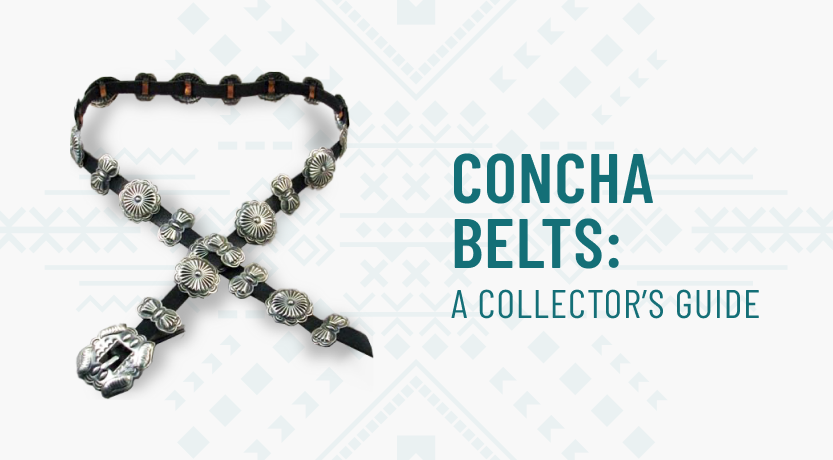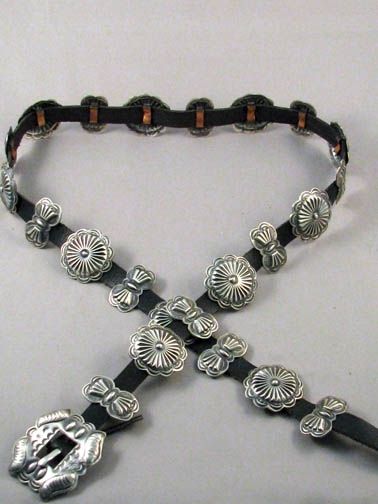
If you’re like us, you’ve been captivated by the intricate beauty and cultural significance of these stunning accessories. Concha belts, sometimes referred to as concho belts, are more than just fashion statements; they are pieces of art that hold a rich history and a special place in the hearts of collectors and admirers alike.
In this guide, we’ll take you on a journey through the world of concha belts, from their origins to how to differentiate between the authentic and the imitation. Let’s get started.
What is a Concha Belt?
A concha belt consists of a leather strap adorned with beautiful silver conchas of various shapes and sizes, often resembling blossoms, bowties, and other intricate designs, culminating in a large, ornate buckle. Concha belts are also known as ‘concho’ belts, the words are synonymous. Both men and women wear concha belts, which look great worn with jeans or dresses.

Vintage Native American Navajo Made Concha Belt
The Origins of the Concha Belt
To truly appreciate the concha belt, we must journey back in time. The term “concha” itself is Spanish for shell, which reflects the intricate patterns often found on the silver conchas. These belts have their roots with the Navajo, a tribe known for their rich artistic traditions.
Surprisingly, the history of concha belts dates back well before the arrival of Europeans in North America. Around 500 BC, some Native American tribes were already skilled in working with metals like copper. However, it was with the arrival of the Spanish in Mexico, particularly in the 1860s, that Native Americans near the border were introduced to the art of silversmithing by Mexican craftsmen. This marked the birth of the iconic concha belt, which would become an emblematic piece of accessory jewelry in the Southwestern United States.
Types of Navajo Concha Belts and How to Authenticate Them
Now that we’ve looked at a brief history, let’s consider the concha belts you might encounter in the market today and how to distinguish authentic from the replicas.
Museum Quality: These are the cream of the crop, crafted by highly skilled traditional Native American artists using the finest stones and Sterling silver. They are true works of art, rarely sold, and primarily reserved for ceremonial purposes. Don’t be surprised if you find such concha belts priced at $20,000 or more.
Authentic Traditional Leather: Crafted by Native American silversmiths, these belts are every bit as exquisite as museum pieces but tend to be somewhat less complex and less expensive. They are versatile and suitable for both casual and formal wear. The concha belts you’ll find at Kachina House are of this ilk.
Authentic Traditional Link: These Sterling Silver link concho belts are perfect for draping over a blouse but can also be threaded through the belt loops of jeans, offering a versatile style statement.
Nickel: Beware of “Nickel Silver” or “German Silver” concha belts, which contain no actual silver. They are made of an alloy of copper, zinc, and nickel and can be machine made, lacking the authenticity of Native American craftsmanship. These are durable and affordable but lack the panache of Sterling silver.
Plated: Plated concha belts, often chrome or thinly silver-plated, are typically tourist-grade or costume jewelry-style belts. They are a world apart from Native American made concho belts in terms of craftsmanship and value.

Vintage Native American Navajo Made Concha Belt with Carnelian
Authentic Navajo Concha Belts at Kachina House
Now that you’ve been introduced to concha belts, we invite you to further explore the world of handmade Navajo concha belts at Kachina House. Whether you’re a collector, a fashion enthusiast, or someone seeking to invest in a piece of Native American art, these belts offer a captivating blend of history, craftsmanship, and style. Embrace the beauty of the Southwest and make a statement with an accessory that tells a story like no other.
Happy collecting!

